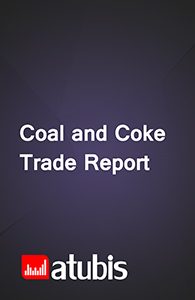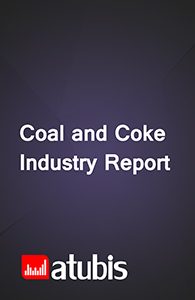Iran’s Coal Coke Market Outlook Report
9,712€
- TRY: 475,000 ₺
Coke is one of the important consumables in the production of steel using blast furnaces; on average, about 600 kg of coke is required to produce one tonne of crude steel. In addition to providing thermal energy for melting in blast furnaces, coke also releases reducing agents (gases) to reduce iron oxide, facilitating the production of iron and steel. Coke is mostly used in blast furnaces to produce steel, but it is also used in other non-metal industries such as sugar industries and power plants.
Product Description
With a GDP of $415 billion in 2019, Iran was the third largest economy in the region that year. While the country’s economy was steadily growing after the drop in 2012 due to the sanctions, it dipped once again in 2019 thanks to the return of the sanctions. With an annual crude steel output of 17 million tonnes, Iran is among the largest producers in the region. About 80% of the country’s crude steel has been produced using electric furnaces. The share of blast furnaces in total steel output has declined over the past years. Owing to the availability of cheap energy carriers such as gas, electric furnaces constitute the largest share of crude steel capacity development; the number of operating blast furnaces is small compared to electric furnaces.
Market drivers of Iran’s coke
Currently, there are a limited number of blast furnace steelmakers in Iran. As new blast furnace plants come online over the coming years, such as the 1.7-million-tonne blast furnace in Zarand, higher blast furnace steel output will boost the demand and consumption of metallurgical coke in the country.
Since most coal reserves in Iran contain thermal coke, the demand for coking coal by producers of metallurgical coke is not completely satisfied. There have been no new exploration operations in the country’s coal reserves. Metallurgical coke producers are expected to face tight coking coal supply over the coming years.
Coking coal is the main raw material in the production of metallurgical coke; the small coking coal capacity in Iran has translated into similarly small capacities in metallurgical coke. Given the limited exploitation of coking coal reserves, domestic capacities of coking coal are not likely to increase over the coming years.
The steelmaking industry is the largest consumer of metallurgical coke, and demand for metallurgical coke increases as steelmaking capacities are expanded. According to the Iran Vision 2025 and plans to ramp up steel capacities, demand for metallurgical coke in consumer industries will strengthen.
Overview of Iran’s coke market
Iran is ranked 29 on a global scale in terms of coal reserves. However, most of the mined coal is lignite, which does not have proper coking properties for metallurgical applications and is mostly used in coal-fired power plants. Thus, metallurgical coke producers meet a sizeable share of their demand for coking coal through imports.
Domestic coke producers are facing numerous challenges in procuring coal; in other words, producers have not yet been able to dominate the entire domestic consumption of high-quality metallurgical coke in the steelmaking industry due to the low quality of Iranian coal. Thus, several hundred thousand tonnes of coke has been imported by Iran every year over the past years to meet part of domestic demand. It should be noted that due to the low quality of domestic coal, producers have to blend domestic and imported coal in order to produce coke for steelmakers; this way, they can deal with the low quality of Iranian coal and manage production costs at the same time. The country is expected to be facing supply deficit of coke due to the lack of quality raw materials needed for the production of high-quality coke. On this basis, considering the negative trade balance in the future, Iran will remain a net importer of coke. According to forecasts, net imports are likely to increase as the Zarand Iranian Steel Co’s blast furnace is commissioned.
Breakdown of Iran’s coke market
Coke produced from coal is either metallurgical coke or thermal coke. The former is used in metal industries, while the latter is used mostly by power plants and sugar industries as fuel. Iran’s coke market is also broken down based on grain size: large, medium, and fine. Large-grain coke is generally used in steelmaking plants and blast furnaces, while fine-grain coke is used in agglomeration plants or other non-metal industries such as sugar and cement. Medium-grain coke is mainly used by ferroalloy producers. Finally, the coke market is also analyzed based on consumer industries. Steelmakers, ferroalloy producers, and foundries are the main consumers of metallurgical coke. Moreover, the consumers of thermal coke are also briefly analyzed.
Key players in Iran’s coke market
- Esfahan Steel Company (ESC)
- Zarand Iranian Steel Co (ZISCo)
- Tabas Coke
- F.I (IRAN FERROALLOYS INDUSTRIES CO)
Additional Information
| Industry | Coal and Coke Consumables |
|---|---|
| Region | Iran |
| Report Type | Industry Report |
Specifications
| Report Attribute | Details |
| The base year for estimation | 2020 |
| Historical data | 2010-2019 |
| Forecast period | 2020-2025 |
| Quantitative units | Value in USD and Volume in Tonne |
| Report coverage | Market Overview, Dynamics, Market Outlook, Risks to Forecast, Consumer Market, Industry Overview, Market Landscape, Competitive Landscape, Market Attractiveness, External Macro Environment Analysis |
| Segments covered | Source, Composition, Type, Application |
| Pricing and purchase options | Please explore our purchase options to meet your exact research needs. |
Reasons to Buy
- Recognize the geographical distribution of import demand
- Identify the current and future key players of the trading market
- Achieve a better insight on potential target markets
- Understand the behavior of major suppliers/customers either globally or regionally
- Identify competitors as a feed for market analysis
Table of Content
- Executive summary
- Introduction
- Objective
- Market under study
- Product
- Product specifications
- Consumption structure
- Applications
- Physical properties
- Subjects discussed
- Geographical scope under study
- Study timeframe
- Study currency
- Potential audience
- Market dynamics
- Market drivers
- Restraints
- Opportunities
- Challenges
- Market overview
- Market size
- Industry capacities
- Existing capacities
- Capacity distribution
- Geographical distribution of capacities
- Future capacities
- Existing capacities
- Output
- Output trends
- Operating rates
- Consumption
- Consumption trend
- Consumption Share of domestic product
- Trade
- Exports
- Imports
- Trade balance
- Market balance
- Market breakdown by product type
- Market breakdown by product type
- Market breakdown by application
- Inventory
- Producers inventory
- Consumers inventory
- Traders inventory
- Market outlook
- Market factors
- Raw materials
- Costs and prices
- Competition
- The government
- Other factors
- Future scenarios
- Risks to forecast
- Market factors
- Consumer markets
- End-user markets
- Building construction
- Infrastructure construction
- Transportation manufacturing
- Industrial equipment manufacturing
- Durable goods manufacturing
- Consumable goods manufacturing
- Direct consumer markets
- Major Direct consumers
- Existing capacities
- Drivers
- Major Direct consumers
- End-user markets
- Export potentials
- Destinations
- Trade and insurance costs
- Import market suppliers
- Producers potential share
- Destinations
- Industry overview
- Raw materials
- The supply volume of raw materials
- Supply channels of raw materials
- Raw materials procurement costs
- Cost structure of producers
- Production cost curve
- Industry value added
- Generated new scrap
- Technology
- Raw materials
- Market landscape
- Domestic sales markets
- Pricing in the domestic market
- Potential domestic demand
- Trade agreements for imports
- Foreign suppliers
- Foreign sales market
- Prices
- Potential markets overview
- Trade agreements for exports
- Foreign customers
- Domestic sales markets
- Competitive landscape
- Producers
- Company profile
- Revenue structure
- Gross profit margins
- Capacity, output and sales
- Consumers
- Company profile
- Revenue structure
- Gross profit margins
- Capacity, output and sales
- Producers
- Market attractiveness
- Industry rivalry
- Threat of new entrants
- Threat of substitutes
- Bargaining power of buyers
- Bargaining power of suppliers
- Conclusion of Porter analysis
- PESTEL analysis
- Political factors
- Economic factors
- Social factors
- Technology factors
- Environmental factors
- Legal factors
- SWOT analysis
- Large-scale companies with favorable conditions
- Short-term strategies
- Long-term strategies
- Large-scale companies with unfavorable conditions
- Short-term strategies
- Long-term strategies
- Small enterprises with favorable conditions
- Short-term strategies
- Long-term strategies
- Small enterprises with unfavorable conditions
- Short-term strategies
- Long-term strategies
- Large-scale companies with favorable conditions
List of Figures
- Output and consumption; 2010-2019
- Market share of product applications; 2019
- Market surplus; 2019-2025
- Production process flowchart
- Market size; 2010-2025
- Existing capacity; 2010-2019
- Capacity distribution; 2019
- Geographic distribution of capacities; 2019
- Development of future capacity; 2010-2025
- Amount of output; 2010-2025
- Operating rates of production plants; 2010-2025
- Amount of consumption; 2010-2025
- Consumption share of domestic product; 2010-2025
- Exports of product; 2010-2019
- Imports of product; 2010-2019
- Historical trade balance; 2010-2019
- Future Market balance; 2021-2025
- Market output breakdown by alloy type; 2010-2025
- Market consumption breakdown by alloy type; 2010-2025
- Market balance breakdown by alloy type; 2010-2025
- Market output breakdown by product type; 2010-2025
- Market consumption breakdown by product type; 2010-2025
- Market balance breakdown by product type; 2010-2025
- Market consumption breakdown by application; 2010-2025
- Inventories of raw materials and products at producers factories; 2010-2019
- Consumers’ inventory of product; 2010-2019
- Traders’ inventory; 2010-2019
- Production forecast, according to raw materials and sales analysis; 2019-2025
- Market surplus; 2019-2025
- The share of end-user industries in the consumption; 2010 and 2019
- Changes in the end-consumption of extrusion products; 2019 vs 2025
- Applications in building construction industry; 2019
- Applications in infrastructure construction industry; 2019
- Applications in transportation manufacturing industry; 2019
- Applications in industrial equipment manufacturing industry; 2019
- Applications in durable goods manufacturing industry; 2019
- Applications in consumable goods manufacturing industry; 2019
- Capacity distribution structure of direct consumers; 2019
- Existing capacities of direct consumers in each province; 2019
- Suppliers of the export potential destination; 2019
- Historical exports to the export potential destination and future potential; 2016-2025
- Up-stream domestic supply; 2010-2019
- Raw materials domestic supply; 2010-2019
- Supply channels of producer plants
- Spot price of raw material in the market; 2010-2025
- Cash cost structure for production the product; 2019
- Production cost curve of the plants; 2019
- Gross value added of the industry; 2010-2019
- Generated new scrap; 2010-2019
- Sales channels
- Realized price of the product in the market; 2010-2025
- Potential demand of each province; 2019
- The main foreign suppliers to the market; 2010-2019
- FOB price vs domestic market; 2010-2025
- Map of global major importers > 20,000t; 2019
- Major foreign customers; 2010-2019
- Revenue structure of the producers; FY2019
- Sales income and gross profit margin of the producers; FY2010-2019
- Output and sales of the producers; FY2010-2019
- Revenue structure of the consumers; FY2019
- Sales income and gross profit margin of the consumers; FY2010-2019
- Output and sales of the consumers; FY2010-2019
- SWOT matrix for large-scale companies with favorable conditions
- Strategies positioning for large-scale companies with favorable conditions
- SWOT matrix for large-scale companies with unfavorable conditions
- Strategies positioning for large-scale companies with unfavorable conditions
- SWOT matrix for small enterprises with favorable conditions
- Strategies positioning for small enterprises with favorable conditions
- SWOT matrix for small enterprises with unfavorable conditions
- Strategies positioning for small enterprises with unfavorable conditions


